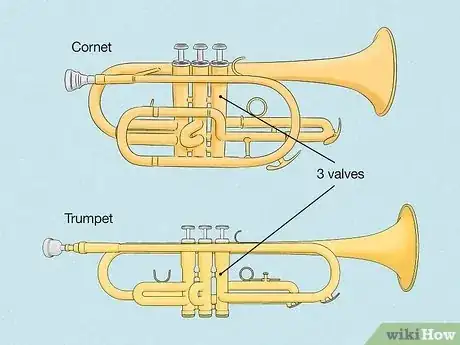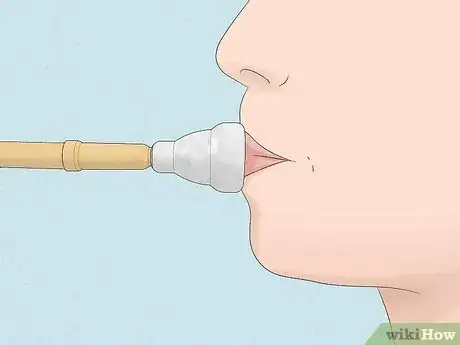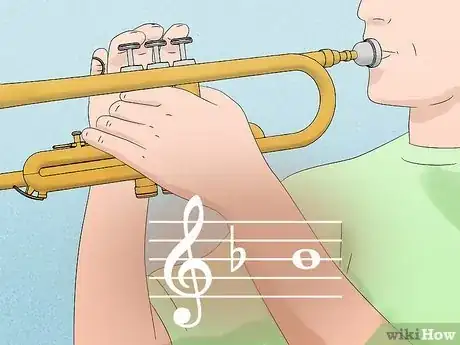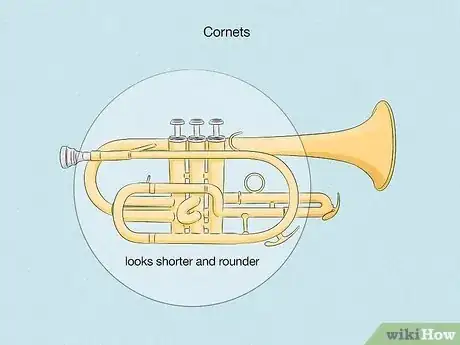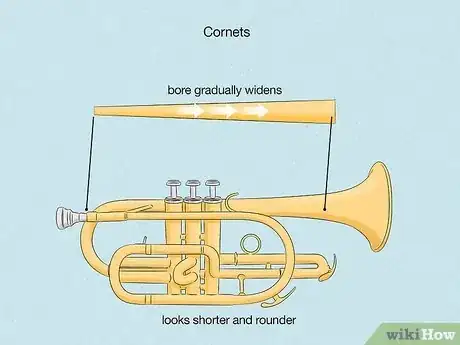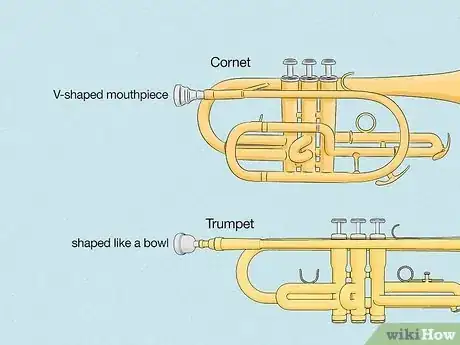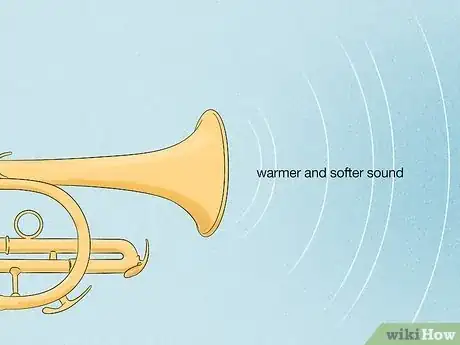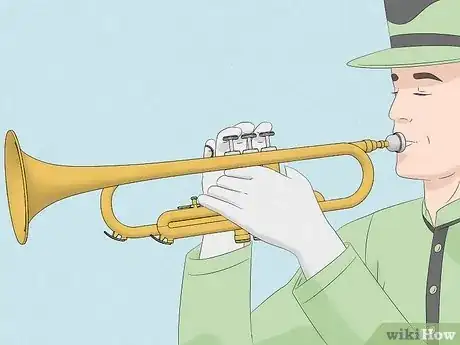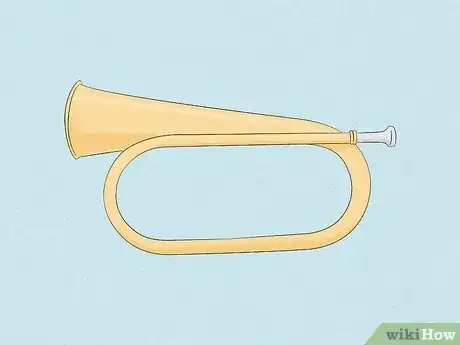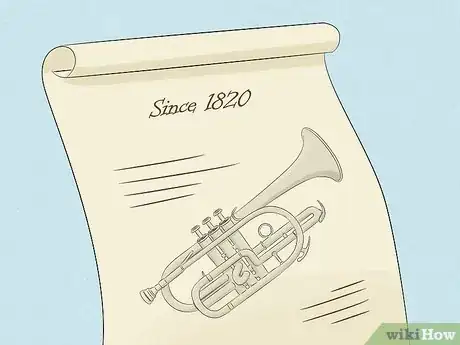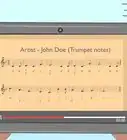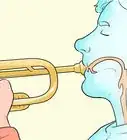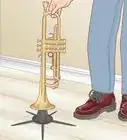This article was co-authored by wikiHow staff writer, Dan Hickey. Dan Hickey is a Writer and Humorist based in Chicago, Illinois. He has published pieces on a variety of online satire sites and has been a member of the wikiHow team since 2022. A former teaching artist at a community music school, Dan enjoys helping people learn new skills they never thought they could master. He graduated with a BM in Clarinet Performance from DePauw University in 2015 and an MM from DePaul University in 2017.
Learn more...
The terms “trumpet” and “cornet” are used almost interchangeably, and from a distance, these instruments look nearly identical—they’re basically the same then, right? Although they look and sound similar, there are subtle differences between the two that span centuries of music history and explain each instrument’s unique role in musical ensembles today. In this article, we’ll cover all of the similarities and differences between these noble horns, including their physical design, their sound, their origins, and more. Let’s jump in!
Things You Should Know
- Cornets and trumpets are both high brass instruments with 3 valves that are pitched in B-flat.
- Cornets have a conical (gradually widening) bore and a deeper mouthpiece compared to trumpets, which gives them a softer, warmer sound.
- Trumpets are more popular globally and are found in orchestras, big bands, and rock, funk, and pop music.
- Cornets are a more niche instrument and are featured in British-style brass bands as well as concert bands and orchestras.
Steps
Similarities
-
1Cornets and trumpets are both high brass instruments with 3 valves. They’re the highest pitched family of the brass instruments with a range of about F#3 to E6 (although professional players may be able to play higher or lower). Both instruments have 3 fingered valves that alter the length of the brass tubing in the body of the instrument, resulting in different notes.[1] X Research source
- Besides the valves, both cornet and trumpet players can also use air pressure and the shape of their lips (their embouchure) to access different notes.
-
2Both horns make sound when the player “buzzes” into the mouthpiece. Like all brass players, cornet and trumpet players form an embouchure with their lips firmly pursed and pressed into the cup of the mouthpiece. When they exhale through their lips, it results in a tight “buzzing” sound that travels through the instrument’s mouthpiece and tubing to become the tone of a trumpet or cornet.[2] X Research source
- High brass instruments, like cornet and trumpet, require a firmer embouchure than low brass instruments with larger mouthpieces, like trombone or tuba.
Advertisement -
3Cornets and trumpets are transposing instruments pitched in B-flat. Transposing instruments are instruments whose written pitches are different from their sounding pitches. For example, when a trumpet or cornet plays their written C, it sounds a whole step lower as a B-flat (that’s why they’re called B-flat instruments). To compensate for this, cornet and trumpet music is written a whole step higher than non-transposing instruments’ music.[3] X Research source
- While B-flat cornets and trumpets are most popular, specialty instruments in C, E-flat, D, and other pitches exist (but are less common).
- Other well known B-flat instruments include clarinet, bass clarinet, soprano saxophone, and tenor saxophone.
- Non-transposing instruments are called C instruments (when they play a written C, it sounds as a C). These include strings, piano, many woodwinds, and pitched percussion instruments.
Design Differences
-
1A cornet’s tubing is more wound up, so it looks shorter and rounder. Cornets and trumpets have the same length of tubing (about 6.5 ft (2.0 m)). However, a cornet’s tubing has four 180-degree turns in it, while a trumpet’s tubing only has 2. This makes cornets look shorter and rounder than trumpets, which look longer and more slender in comparison.[4] X Research source
-
2Cornets have a conical bore while trumpets have a cylindrical bore. A wind instrument’s bore refers to the shape of the inside of its tubing. On a cornet, the bore gradually widens from the receiver (the end of the tubing where the mouthpiece is inserted) all the way to the bell (the flared end of the tubing where the sound comes out). Trumpet bores, on the other hand, have the same diameter from the receiver up until the last third of the tubing, which starts to widen toward the bell.[6] X Research source
- The trumpet’s cylindrical bore gives it a louder, brighter, more piercing sound than the cornet’s conical bore, which produces a warmer, rounder sound.
- Conical bores allow sound waves to get wider as they travel toward the bell, resulting in a gentler, more diffuse sound.
Mouthpiece Differences
-
Cornets have a deeper, more V-shaped mouthpiece than trumpets. A trumpet mouthpiece has a shallow, round interior cup shaped like a bowl. A cornet mouthpiece more closely resembles the mouthpieces of other brass instruments—it’s deeper than a trumpet’s, and the interior shape of the cup is longer and more angled (like the letter “V”).[7] X Research source
- The cornet’s deeper mouthpiece allows sound waves to vibrate more freely, which contributes to its warmer sound (especially in the lower register).
- Trumpet mouthpieces force the soundwaves to be more focused. This is why trumpets can “cut” through large ensembles more easily than cornets.
- A cornet mouthpiece is less resistant than a trumpet mouthpiece. This (plus the instrument’s smaller size) makes it a better option for children, who might not have the “air power” to get a great sound on trumpet.[8] X Research source
Tone Comparison
-
Cornets sound subtly warmer and softer than trumpets. Because of the cornet’s conical bore and deeper mouthpiece, it produces a more lyrical and gentle tone than the trumpet, which is brighter and more piercing. Cornets also have a softer dynamic range, while trumpets can easily blast over large groups of other instruments (especially in the higher part of their range).[9] X Research source
- The difference in tone was more noticeable in the early 19th century, when some trumpets were still valveless and cornets were new.
- Modern cornets and trumpets sound much similar, and it’s more difficult to blindly distinguish between the two.
- In music, “dynamics” refers to the volume of the sound an instrument or ensemble plays.
Ensemble Uses & Popularity
-
Trumpets are more popular and appear in more ensembles and genres. In terms of sales quantity, trumpets dominate the high brass market worldwide.[10] X Research source They're found in symphony orchestras, concert bands, jazz ensembles and big bands, military bands, and the horn sections in rock, funk, and pop music. Cornets can be found in these groups as well, but are more prominently featured British-style brass bands and some wind ensembles or concert bands.[11] X Research source
- Trumpet parts are often written to “soar” above the ensemble, while cornets help fill out the interior of the ensemble’s sound.
- Ensembles in the 19th and early 20th centuries used trumpets and cornets together for their different sounds and capabilities.
- Today, it's rarer to see both instruments together outside brass bands and some concert bands since modern trumpets can play advanced cornet parts.
- Cornets are popular in beginning student bands because of their smaller size, warmer sound, and easier-blowing mouthpiece. Beginning adults can begin on whichever instrument they prefer.
Origins
-
1Trumpets evolved from ancient, valveless horns. Trumpets have been around in one form or another for around 3,500 years. Until the 19th century, they had no valves—players simply changed pitch with air pressure and embouchure movements. This resulted in a tradition of powerful, high-register playing, but with a narrow range of available pitches (imagine a group of trumpeters playing a royal fanfare or a strident military call).[12] X Research source
- These instruments are called “natural” trumpets and are sometimes still seen today in period ensembles specializing in “historically accurate” performances.
-
2The cornet was invented in the 1820s to play complex, melodic music. Cornets were devised by adding valves to a post horn (a circular, valveless horn with a rich middle register) that allowed a full range of notes to be played. They were immediately popular because of their flexibility, wider range of notes, and melodic power in the “vocal” range (the middle range that natural trumpets struggled to project in).[13] X Research source
- Valved trumpets were invented just a few years later, but took much longer to catch on since so much music had already been written for natural trumpets.
You Might Also Like

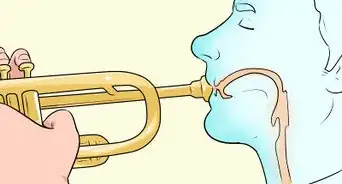
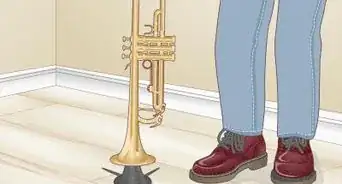


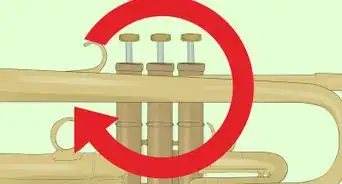


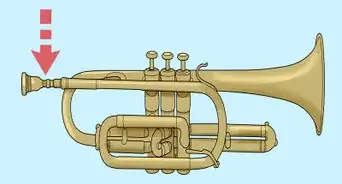
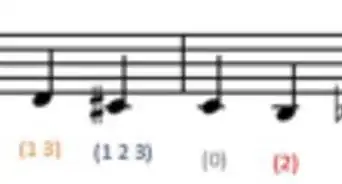
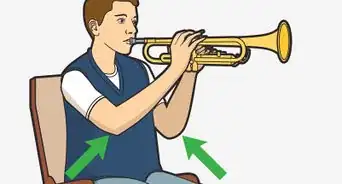



References
- ↑ https://topmusictips.com/trumpet-vs-cornet-vs-flugelhorn/
- ↑ https://banddirector.com/brass/trumpet/trumpet-cornet-embouchure-tips-for-beginners/
- ↑ https://topmusictips.com/trumpet-vs-cornet-vs-flugelhorn/
- ↑ https://musicalinstrumentguide.com/cornet-vs-trumpet/
- ↑ https://musicalinstrumentguide.com/cornet-vs-trumpet/
- ↑ https://jazztimes.com/features/profiles/cornet-horn-trumpet/
- ↑ https://jazztimes.com/features/profiles/cornet-horn-trumpet/
- ↑ http://apps.texasbandmasters.org/archives/pdfs/bmr/2004-12-strange1.pdf
- ↑ http://apps.texasbandmasters.org/archives/pdfs/bmr/2004-12-strange1.pdf
About This Article

